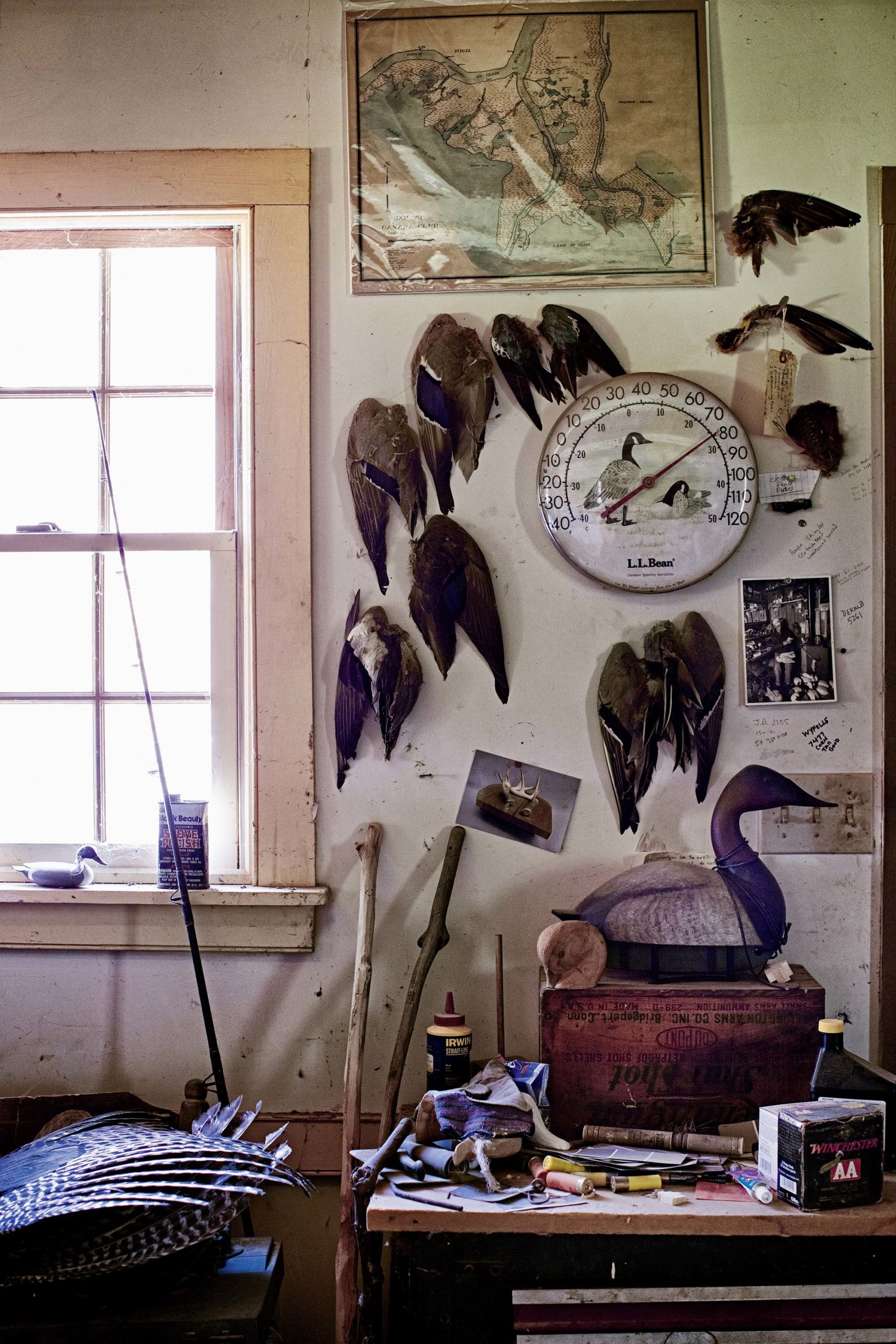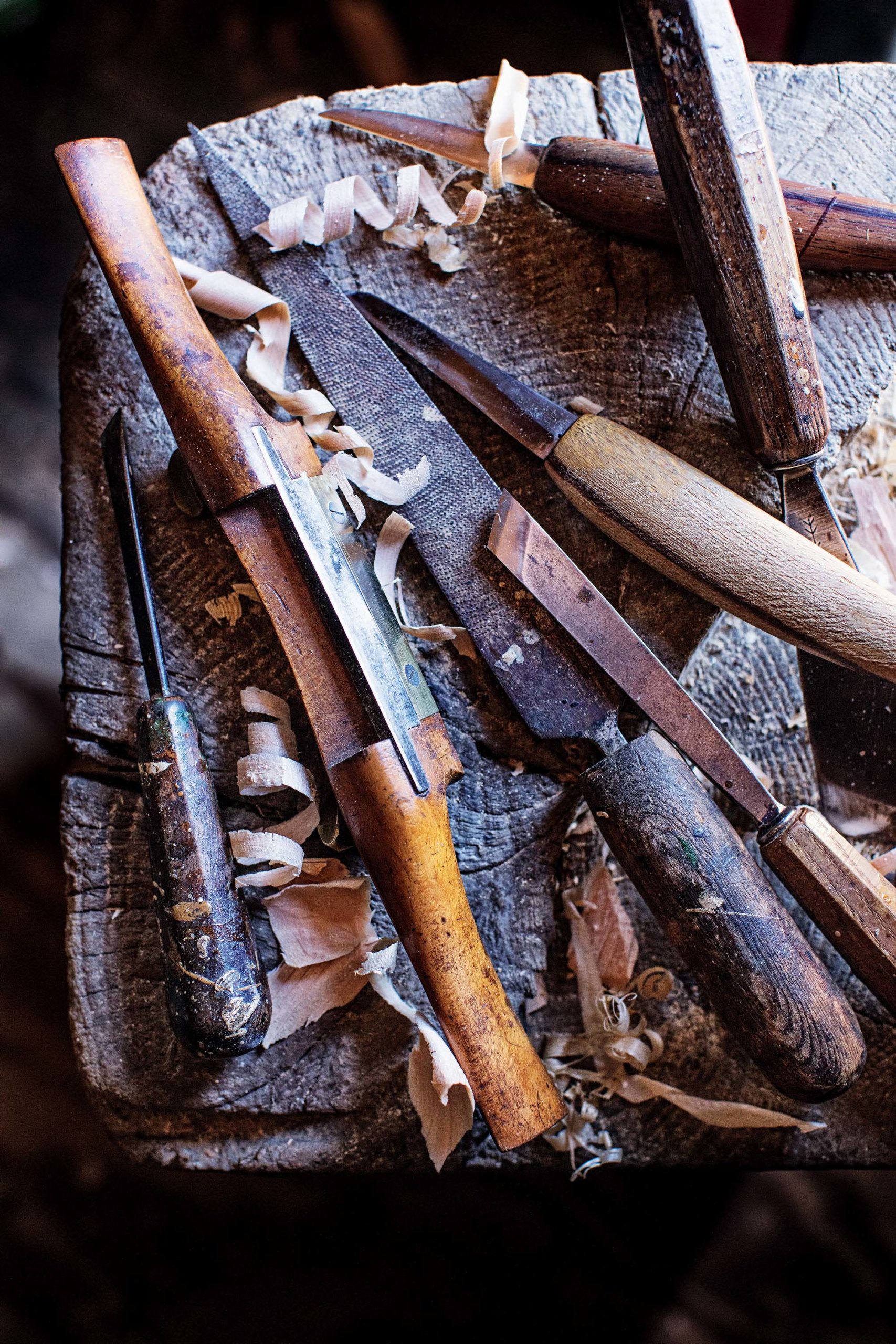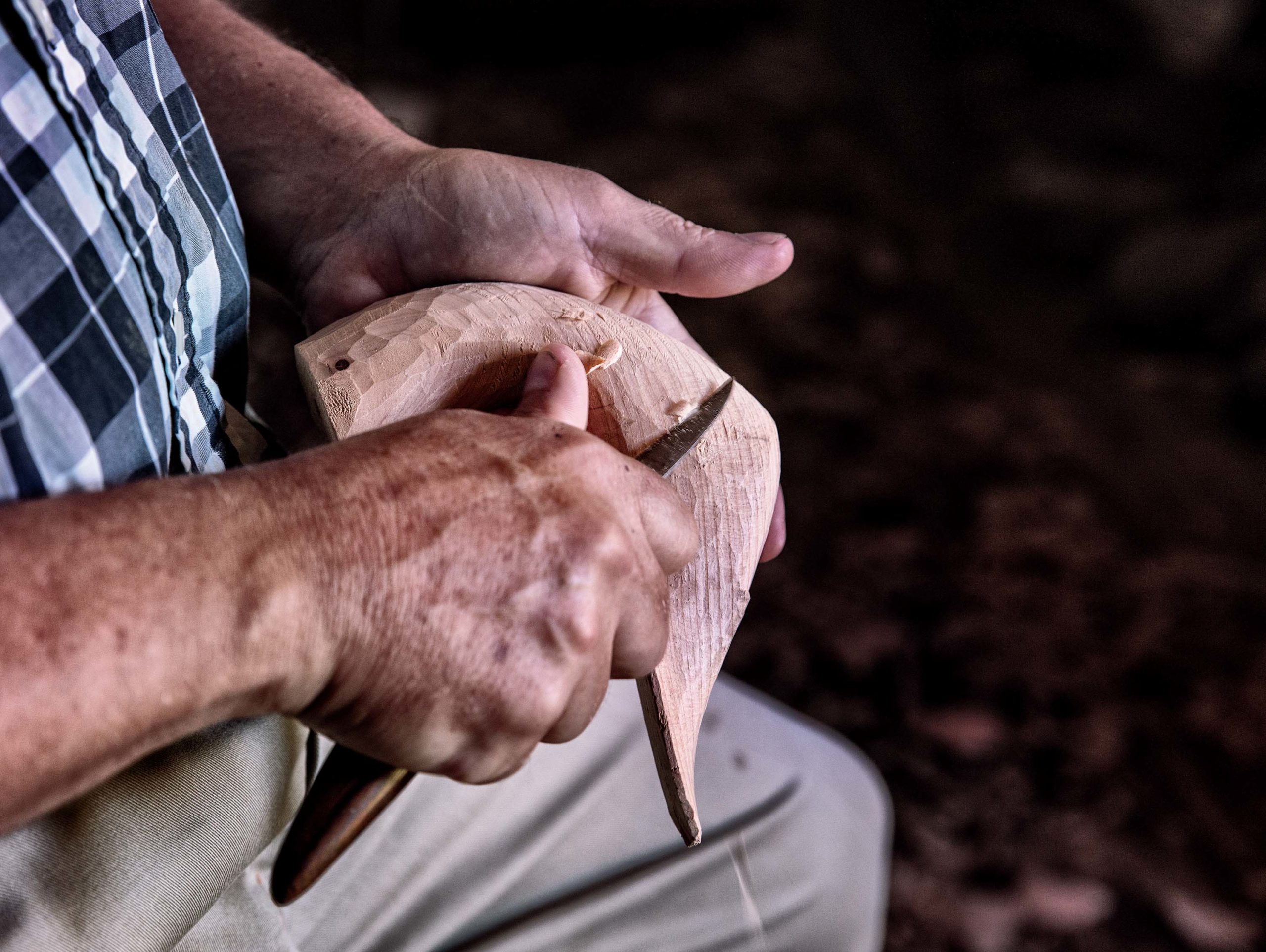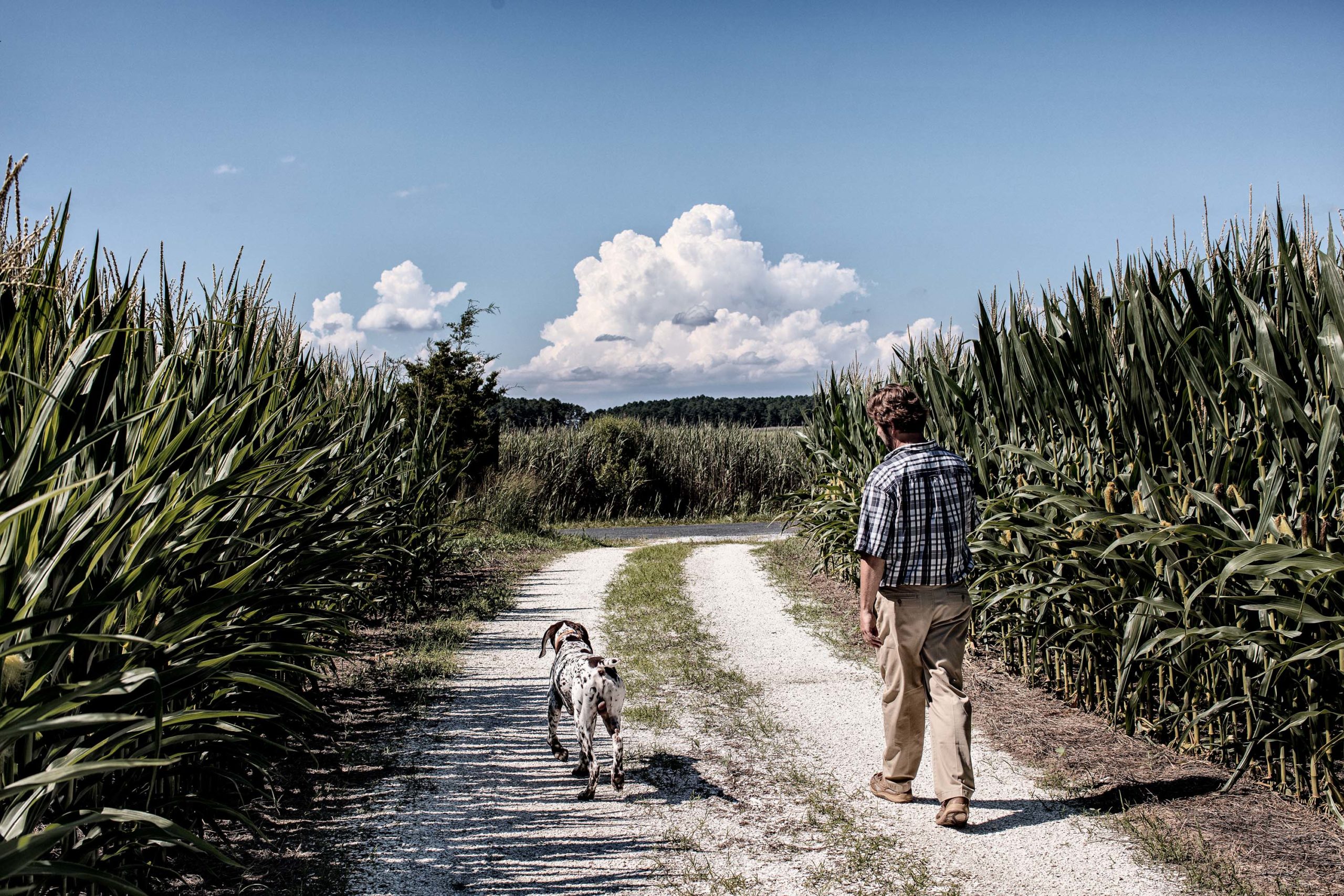Sporting
Cameron McIntyre’s One-of-a-Kind Decoys
The Virginia artist carries on the legacy of the master carvers of old. He lives much like them, too

Photo: Anna Williams
McIntyre refines a Canada goose in his backyard studio after chopping out the decoy’s rough shape with a hatchet.
Ironically, Cameron McIntyre could probably bag his limit of ducks without the assistance of decoys.
Situated as he is, several back roads removed from the main drag through rural Accomack County on the famed waterfowling peninsula of Virginia’s Eastern Shore, and more specifically, on 180 acres of brackish marsh and oft-flooded farmland between the Pocomoke River and Bullbegger Creek, he might randomly fire a shotgun out his bathroom window in season with a reasonable chance of success.
Yes, that would be peculiar for several reasons, not least because there is perhaps no more accomplished carver of traditional wooden decoys plying the craft today than McIntyre, using only his calloused hands and a limited arsenal of antique edge tools, as it was done a century and longer ago. Granted, there aren’t legions pursuing that particular calling—and that’s kind of the point.
“Just a handful of guys are doing it like this, and some of them have jobs and carve on the side,” says the fifty-one-year-old as he pencils a few guiding marks onto a knotless block of white cedar inside his garage-sized backyard studio, surrounded by smudged sketchbooks, painting supplies, and dried duck wings of myriad feather patterns. “I basically didn’t have any other options. I wasn’t going to work in a cubicle somewhere. If I am good at what I do, a big part of it is because I had to get good.”

Photo: Anna Williams
Duck wings line a wall in the studio.
“I think Cameron was born a hundred, maybe two hundred years too late,” says Jon Deeter, of the leading decoy auction house Guyette & Deeter, and McIntyre’s occasional hunting companion. “He could have been a decoy carver in 1825. He’s an old soul, like a Hemingway type. He’s just earthy, cool, and very talented.”
How talented? “Cameron is the definition of a master carver,” says Dan Thiel, the executive secretary of Ducks Unlimited, which along with Guyette & Deeter has used McIntyre’s also-considerable skills as a restorer on antique decoys. “It’s in the research he conducts and the quality of his work. He truly carries on the tradition of generations of carvers before him.”
Chop! Chip, chop! Chop!
McIntyre wields his trusty old Plumb hatchet with dexterity and surprising speed, pausing only to reevaluate his progress on the white cedar block every dozen or so swings. Sometimes the keen steel blade shears clean through; sometimes it bites and he pops out the piece with a flick of the wrist. As slivers tumble around his tree-trunk chopping station, the rough ovoid contours of a Canada goose’s body emerge. The same labor unveils the goose’s head from a bent piece of dense red cedar, chosen to strengthen the long neck.

Photo: Anna Williams
A primitive root-head goose decoy.
“When I was young and first heard about guys chopping decoys out with a hatchet, I thought that was neat,” he says. “So I gave it a shot, and it was totally awkward. I thought there was no way in hell I was ever going to figure it out.”
McIntyre’s first attempts at decoy carving actually predate that, when as a boy he ordered a DIY kit from the back of a magazine and inauspiciously laid open his palm at the kitchen table with the plastic-handled knife. The scar is still visible.
But, really, this origin story begins with the artistically inclined boy immersing himself in the natural surroundings of his then home in Beaufort, South Carolina, in the heart of the Sea Islands and the Lowcountry.
“I’d go out and spend the night by myself in my boat in the dead of winter, because I was obsessed with the marshes,” he says. That fixation extended to a family tradition of duck hunting. “We always got out there plenty early, before dawn. We’d sit in the blind, and I could hear the pintails whistling over and the mallards quacking and smell the marsh. All that had a big impact on me.”
After the hatchet work, McIntyre places the decoy in a vise he has owned since he was twelve years old and deploys a succession of vintage specialty tools—drawknife, skew chisel, spokeshave—to refine the goose’s graceful lines.
“I won’t say there are no good tools made today, but almost all of mine are old, like from nineteenth-century Sheffield, England,” he says. “You want quality steel, those old Sheffield tools are hard to beat.”

Photo: Anna Williams
Vintage tools including a rasp, a spokeshave, and chisels.
He eschews the power tools some contemporary decoy purveyors use to speed up production. Also notably absent are the distractions of a computer or a phone. Or a decent chair, since he believes that stepping back and adjusting his perspective improves the work. As he pulls the drawknife through the cedar in steady arcs toward his chest, it’s apparent that McIntyre himself is a well-honed implement in this endeavor, every cut calibrated by his wrists, arms, and shoulders. And since sight and instinct are all that guide each stroke, no two decoys ever turn out the same.
“Even though I’ve never made a goose that looks exactly like this one, I know where to take off the wood to get the shape I’m after,” he says. “It’s hand-eye coordination, it’s muscle memory, and when you’ve done it long enough, it happens on a subconscious level. I’ve spent pretty much my entire life figuring this out.”
He’s unabashedly partial to carving canvasbacks and puddle ducks—mallards, pintails, teal, gadwall—because he’s also unabashedly partial to eating those ducks. “People ask me to make a bufflehead,” he says, shrugging, “but they aren’t good to eat and I don’t shoot them, so I don’t make them.” Simple as that.
Spend a day with McIntyre and it becomes clear that unwinding the artist from the sportsman is impossible—one could not exist without the other. Even when he studied painting and drawing for a while at the University of South Carolina and the Gibbes Museum of Art in Charleston, he remained immersed in waterfowling culture. And when he moved to the Eastern Shore after becoming smitten with its landscape and the legacy of carvers such as Ira Hudson and the Ward brothers, his growing reputation as a carver followed.
By then, duck hunters had long since switched en masse to factory-produced, thermoplastic decoys. And as these things tend to go, the decline of the carved decoy as hunting aid was mirrored by its rise as true American folk art, sparking a collectors’ frenzy that led to the record auction in 2007 of a single merganser by nineteenth-century Massachusetts carver Lothrop Holmes for an otherworldly $856,000.
This rarefied marketplace created a niche for McIntyre’s work, so influenced by those old masters but more economical. Well, relatively more economical, at about $2,000 per commission, whether he’s asked to complete a decoy with a pristine paint job or to create layers of distress to evoke what might have been stashed in Grandpa’s shed for fifty years.

Photo: Anna Williams
McIntyre’s experienced hands shape a canvasback head.
“I experiment so much with the paint and the patina that it borders on madness,” he says. The majority of a decoy’s average three-week turnaround is devoted to painting, with McIntyre applying layer upon layer of oil-based media to achieve what’s in his mind’s eye, maybe mellow and glowing, maybe dry and salty. And if he doesn’t, he starts over.
Naturally, he hunts with decoys of his own design, including a rig of six stunning mallards. Surprisingly, he estimates that 20 percent of his clients drag these collectible art objects into the muck of the field, from Ontario to South Dakota to an undisclosed club’s famous hole in Arkansas. Indulgent? Perhaps, he acknowledges, but he draws a comparison to anglers content with an $800 jon boat while others must have a $10,000 cedar-strip canoe.
“When you get a decoy from Cameron, you know that nobody else got a similar piece,” says Joe Engers, the longtime editor and publisher of Decoy Magazine. “It’s his own interpretation. He’s not making it as much for you as for himself.”
Authenticity is an odd notion when applied to an instrument of deception, which is, of course, a decoy’s original purpose. But starting with the simple sketches McIntyre draws before lifting his hatchet, he’s focused on what is authentic to him, such as knowing that when a duck turns its head, it throws its symmetry a bit off and the tail might tilt in the other direction.
“The number one thing I’m interested in is the sculptural form,” he says. “People are starting to appreciate that simple, more primitive things have artistic merit. What I’m doing has a certain quality, but it’s not about level of detail. I could make a superrealistic decoy if I wanted to—and I don’t want to. I do it this way because that’s what I love.”
When McIntyre arrives at a good stopping place on the goose, and finds that his wife, Adele, is still frying up a lunch of extra-meaty crab cake sandwiches in the meticulously restored farmhouse they share with their two teenage boys and an affable German shorthaired pointer, he requires little prodding to take a break outdoors.
Adjacent to his spread is a broad indigo twist in the Pocomoke River, marking the border with Maryland on the other side and just a few bends upstream from the Chesapeake Bay. Bygone watermen landed skiffs here to load tobacco, all the way back to Jamestown settler John Smith making a stop during his 1608 mapping expedition.
It is a stirring view, which McIntyre has captured several times in his other creative endeavor, landscape painting. But not as it appears at this moment, sparkling under a warm midday sun. “I’m a winter person—it can’t be too cold or blowing for me,” he says. “And I love dark, early morning scenes. That comes from hunting a mile deep in the woods at those magic hours. When you come home cold, tired, and hungry, you replay all that in your mind. I like to associate those feelings with the place that I’m painting. It’s got a mystery to it.”

Photo: Anna Williams
McIntyre with his German shorthaired pointer by the Pocomoke River.
It certainly does. Almost all of his paintings, depicting the marshes, creeks, and pinewoods of his home, capture a solitary murk subtly imbued by a sub-horizon glimmer. The style is impressionistic; McIntyre credits his recently departed mentor, the lauded landscape artist Russell Chatham, as a deep influence.
What you won’t see in McIntyre’s paintings are ducks—or for that matter, any fauna. “That’s on purpose,” he says. “I know ducks, and I’d do an adequate job of painting them, but when you have a landscape with a bird in it, that scene is dominated by that bird, like a sailboat on a seascape. Devoid of people or animals, it forces you to relate to something else. It’s pure nature—are you moved by it or not?”
That provocative question also applies to a different sort of waterfowl carving that he has pursued of late. These works aren’t decoys—indeed, they might be considered the opposite, depicting dead birds dangling upside down by their legs, as if after a successful hunt. The nature morte sculptures hearken back to nineteenth-century carvings by the renowned American artist Alexander Pope Jr. and seventeenth-century Dutch still lifes. McIntyre renders them softer and more realistic than his decoys, and the effect is transfixing, or unsettling, based on the viewer’s sensitivities.
“These pieces challenge the instant gratification we’ve become so accustomed to,” says Zac Zetterberg, a curator at the Peoria Riverfront Museum in Illinois, which had six of McIntyre’s hanging game sculptures on exhibition this summer. “There was a time when it was a big deal to have a couple of geese hanging on the barn, because it meant you were going to eat. Cameron lives that sort of lifestyle, and I think he’s trying to get at something.”
McIntyre proudly concludes the tour in the corner of his backyard where he and his sons clean ducks during the season. “I haven’t bought beef from a grocery store in thirty years,” he says. “We live on deer, ducks, geese, and doves. We garden and chop our own firewood. I’m not a survivalist, but I want to live as close to nature as I can. I’m glad I can pass that down to my boys, and I’ve told them they have to do the same when they have kids.”

Photo: Anna Williams
The main road leading to his Eastern Shore farm.
To that end, McIntyre has put the property into conservation easement with the Virginia Eastern Shore Land Trust, which means it will never be sold for development. “Some people think easement means you don’t trust future generations,” he says. “And that’s true, I don’t. There are enough strip malls and parking lots already. This land deserves to be protected.”
Right now, though, there’s the goose decoy to finish, a landscape in progress perched on an easel in the studio’s painting nook, and a fresh commission to ponder. Demand certainly exists to make and sell more work. Still, opening day is approaching, and McIntyre is an artist who knows how to carve out the space he needs to restore his creative spirit.
“If I’m being honest, there was a time when I didn’t work at all from about mid-November until the end of duck season,” he says. “Nowadays, I still devote the whole month of January to being in a blind. Then come February, I’m way behind.”
This article appears in the October/November 2020 issue of Garden & Gun. Start your subscription here or give a gift subscription here.







